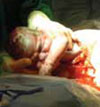
BECAUSE OF PREMATURE CONTRACTIONS and bleeding, a woman underwent cesarean delivery by her ObGyns. When Dr. A reached in to extract the fetus, it floated away. Dr. B then attempted delivery while Dr. A applied fundal pressure. Photographs of the baby taken by the father 2 minutes after birth showed severe bruising over the liver area. Sonography performed shortly after birth revealed a liver laceration. Surgery to repair the liver was unsuccessful. The infant died.
ESTATE’S CLAIM The trauma from improper fundal pressure and improper manipulation when extracting the infant through an inadequately sized incision caused the liver to rupture. A vertical incision should have been made initially, instead of a transverse incision, because of the small size of the fetus and uterus. When the fetus could not be extracted, a reverse “T” incision should have been made so the fetus could be extracted without trauma.
PHYSICIANS’ DEFENSE The mother had a preexisting disorder that caused bleeding before delivery; the liver laceration occurred hours before delivery.
VERDICT A $1,461,507 Maryland verdict was returned, including $461,507 to the infant’s estate, and $500,000 to each parent.
Perforated colon after hysteroscopy
A 44-YEAR-OLD WOMAN UNDERWENT hysteroscopic surgery to remove polyps and a fibroid tumor. During the procedure, the ObGyn used a hysteroscopic resection loop. Two days later, the patient developed peritonitis. A perforation was detected, requiring resection of part of the colon and a temporary colostomy.
PATIENT’S CLAIM The injury occurred when the ObGyn pushed the resection loop of the hysteroscope through the uterus, burning a hole in the uterus and the colon. The ObGyn should have performed a more extensive check to ensure that no perforation had occurred.
PHYSICIAN’S DEFENSE Perforation was a delayed thermal effect that did not occur until 2 days after the procedure. There was no negligence.
VERDICT A $1.55 million New York verdict was returned.
Did retractors cause neuropathy?
AFTER CERVICAL CANCER was diagnosed, a 37-year-old woman was referred to a gynecologic oncologist. He performed a modified radical hysterectomy with pelvic node dissection and lymphadenectomy. A Pfannenstiel incision was used, and the procedure involved removal of the uterus, cervix, upper quarter of the vagina, pelvic lymph nodes, and surrounding tissue. Surgery lasted longer than 5 hours.
The next day, the patient reported pain, burning, tingling, and numbness in her left thigh, which was eventually diagnosed as lateral femoral cutaneous neuropathy. This condition did not resolve.
PATIENT’S CLAIM The surgeon failed to reposition retractors with sufficient frequency. He allowed the retractor blades to press on the psoas muscles, thus injuring the lateral femoral cutaneous nerve.
PHYSICIAN’S DEFENSE The retractors were used properly; they were periodically shifted to gain better exposure to the surgical area. The surgeon also used his hands to determine that the retractors were properly positioned.
VERDICT An Illinois defense verdict was returned.
“I would have terminated my pregnancy if…”
A PREGNANT WOMAN UNDERWENT a blood test that indicated that the fetus had an elevated risk of being born with Down syndrome. The child was born 7 months later with Down syndrome.
PATIENT’S CLAIM She was not told of the increased risk that her child would have Down syndrome. If she had been informed, she would have terminated the pregnancy.
PHYSICIAN’S DEFENSE According to the physician’s records, the mother was told the blood test results many times. Amniocentesis was recommended, but the mother had declined.
VERDICT A Maryland defense verdict was returned.

